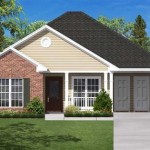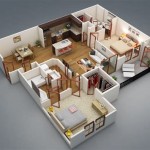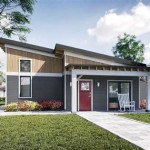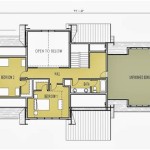House Plans Designed to Maximize Front Views
The allure of a captivating view is a significant driver for many prospective homeowners. A well-designed house plan can transform a stunning panorama into an integral part of everyday living. Optimizing a home's architecture to frame and enhance the view requires careful consideration of site orientation, window placement, room layout, and the integration of outdoor spaces. This article explores key design principles used in house plans that prioritize the enhancement and enjoyment of front views.
Strategic Site Orientation and Home Placement
The first and arguably most important step in designing a house with a focus on the front view is a thorough assessment of the building site. The orientation of the lot relative to the view, the sun's path, prevailing winds, and any potential obstructions must be carefully analyzed. Ideally, the house should be positioned to maximize the view while minimizing the impact of undesirable environmental factors.
For instance, if the prime view faces west, strategies to mitigate intense afternoon sun, such as deep overhangs, strategically planted trees, or solar control window films, are crucial. Conversely, if the view faces north, maximizing natural light penetration becomes a priority. This might involve using larger windows, skylights, or light wells to capture and distribute sunlight throughout the home.
The placement of the house on the lot also influences the perceived quality of the view. Elevating the house slightly, even by a few feet, can significantly expand the visible landscape. Similarly, setting the house back from the street can create a sense of privacy and enhance the feeling of connection with the view. Professional topographic surveys and site analysis reports are invaluable tools in making informed decisions about site orientation and home placement.
Furthermore, considering the existing landscape and vegetation is crucial. Mature trees can frame the view, provide shade, and create a sense of enclosure. Conversely, overgrown vegetation can obstruct the view and create maintenance challenges. A landscape architect can help to develop a plan that complements the house design and enhances the overall viewing experience.
Optimizing Window Placement and Size
Once the house is properly oriented and positioned, the next step is to carefully consider the placement and size of windows. Windows are the primary conduits for bringing the view into the home, and their strategic placement can dramatically impact the quality of the visual experience. The size and shape of windows should be proportional to the scale of the room and the nature of the view.
Large picture windows are ideal for capturing panoramic vistas, while smaller, strategically placed windows can frame specific features of the landscape. Casement windows and awning windows offer unobstructed views when open, while sliding windows provide flexibility in ventilation and viewing options. Bay windows can extend the living space into the view, creating a cozy nook for reading or relaxation.
The placement of windows should also consider the interior layout of the home. Rooms with a direct connection to the view, such as the living room, dining room, and master bedroom, should be prioritized. In open-concept floor plans, large windows can create a seamless transition between interior and exterior spaces, blurring the boundaries between the home and the surrounding landscape.
Beyond aesthetics, careful consideration should be given to the thermal performance of windows. Energy-efficient windows with low-E coatings can reduce heat gain in the summer and heat loss in the winter, contributing to a comfortable and energy-efficient home. The orientation of the windows also affects their exposure to sunlight, and appropriate shading devices, such as overhangs or blinds, may be necessary to control glare and heat gain.
Window material is another critical consideration. Wood frames offer a classic aesthetic and excellent insulation, while vinyl frames are durable and low-maintenance. Aluminum frames are strong and lightweight, but they are less energy-efficient than wood or vinyl. The choice of window material should be based on a balance of aesthetic preferences, performance requirements, and budget constraints.
Integrating Indoor and Outdoor Spaces
A house plan designed to maximize front views should seamlessly integrate indoor and outdoor spaces. Outdoor living areas, such as decks, patios, and porches, can extend the living space and provide opportunities to enjoy the view in a more immersive setting. The design of these outdoor spaces should complement the architecture of the house and create a cohesive visual experience.
Decks and patios can be positioned to take full advantage of the view, providing ample space for outdoor dining, entertaining, or simply relaxing. Covered porches offer protection from the elements, allowing residents to enjoy the view even in inclement weather. Pergolas and trellises can provide shade and create a sense of enclosure, while still allowing for unobstructed views.
The use of sliding glass doors or bi-fold doors can create a seamless transition between indoor and outdoor spaces, blurring the boundaries between the home and the surrounding landscape. These doors can be opened wide to create a spacious and airy living area, perfect for enjoying the view and the fresh air. The choice of materials for outdoor spaces should be durable, weather-resistant, and aesthetically pleasing.
Landscaping plays a crucial role in integrating indoor and outdoor spaces. Carefully planned landscaping can enhance the view, create privacy, and provide a sense of connection with nature. Native plants are a good choice for landscaping, as they are well-adapted to the local climate and require less maintenance. A landscape architect can help to develop a plan that complements the house design and enhances the overall viewing experience, creating a harmonious blend of architecture and nature.
Moreover, the use of outdoor lighting can extend the enjoyment of the view into the evening hours. Strategically placed lighting can highlight architectural features, illuminate pathways, and create a warm and inviting ambiance. Low-voltage lighting is a good choice for outdoor lighting, as it is energy-efficient and safe for use around plants and people.
In conclusion, designing a house plan to maximize front views requires a holistic approach that considers site orientation, window placement, room layout, and the integration of indoor and outdoor spaces. By carefully considering these factors, homeowners can create a home that not only provides a comfortable and functional living space but also celebrates the beauty of the surrounding landscape.
Careful consideration must also be given to local building codes and regulations. These codes may dictate setbacks from property lines, height restrictions, and other parameters that can impact the design and placement of the house. Consulting with a qualified architect or engineer is essential to ensure that the house plan complies with all applicable regulations.
Furthermore, the long-term maintenance of the house and the surrounding landscape should be considered. Selecting durable materials, implementing proper drainage systems, and establishing a regular maintenance schedule can help to ensure that the house remains a beautiful and functional place to live for many years to come. The initial investment in a well-designed house plan that maximizes front views can provide years of enjoyment and enhance the overall value of the property.
Finally, it's important to remember that the best house plan is one that reflects the unique needs and preferences of the homeowner. Working closely with an architect or designer can help to create a custom house plan that perfectly captures the desired aesthetic, functionality, and viewing experience. The result is a home that is not only beautiful and functional but also a true reflection of the homeowner's individual style and lifestyle.

Small House Left Right And Perspective Elevation With Ground Floor Plan Details Dwg File Simple Plans One

Layout Plan Of House With Prospective View And Diffe Section In Autocad File Ground Floor Plans Open

Drawing Of House Plan With Elevation Details In Dwg File Design Plans

29x48 House Plan Design 3d Front Elevation 1392 Sq Ft 6 Bedroom

32x53 3 Bhk Duplex House Plan Front View Design 1738 75 Sq Ft

View Home Sloping Lot Multi Level House Plan 3d 360 Basement Plans Luxury

65x75 House Plan 4 Bedroom Villa Modern Front Design 4875

Right Left Front And Rear Elevation Details Of One Family House Dwg File Open Plans 2bhk Plan Bungalow Design

Left Right Front And Rear View Of Bungalows Dwg File Open House Plans 2bhk Plan Bungalow Design

House Plan Fern View








